|
As the final Lancia Lybra
rolls out of the Mirafiori factory
this month after a six-year stint as Lancia’s
mainstay in the compact executive segment, we pay tribute to this excellent, yet
always underrated wearer of the famous badge.
The Lybra's death brings to an end, at least temporarily, Lancia’s offerings in the compact executive class, a line which
stretches back from the Lybra to the Dedra, Prisma, Beta and Flavia/2000. Instead, its place will at least partly be filled by Fiat’s all-new D-segment
contender, the Croma. With lessons drawn from Lancia’s top-of-the-range Thesis
saloon, the new Fiat represents a logical successor, especially as its interior
has, in more than one instance, been noted (in favourable terms) as being
similar to that of a Lancia.
The Lybra was
originally conceived under the direction of the then-head of Lancia Centro Stile
(since late 1991), Enrico Fumia,
although external design house I.DE.A. had a hand in the car’s genesis.
This was normally the case, as with the Ypsilon, I.DE.A and
Fiat styling centres were drafted in for exterior and interior design proposals.
But Fiat’s CEO during that period, Paolo Cantarella, made a conscious decision
to favour in-house designs over the work of I.DE.A., Pininfarina, Bertone, and
Italdesign, because he felt that only in-house designs could establish a clear
marque identity.
Fumia’s original sketches and models, dating from
1992, showed a clear resemblance to the 1995 Lancia Y, which was penned at
around the same time. In particular, the projected nose and tail treatments
were extremely similar to the smaller car, (its
stylistic orientation was already clearly defined in the initial concept drawing
where Enrico Fumia developed the graphic theme around the lozenge shape
described by headlamps and grille deriving from the geometry of the Lancia
shield), while the overall proposal showed a marked resemblance to the
elegant, yet-to-be-released, Peugeot 406. "Looking at the Lancia models of
the past, we identified a series of styling cues,
‘guidelines’ you might say, to interpret and not just
replicate,” said Fumia at the time.
However, the
car’s gestation was not to be completed without a hiccup or two. In mid-1996,
the car was sent back to the drawing board. This was the year when Mike Robinson
became Director of Design at Centro Stile
Lancia – and he is often credited with the Lybra design. Robinson worked up a small
variety of alternative noses, with the additional constraint of having to work
around the fact that only limited changes could be made to the tooling. He
obviously tried to steer the Lybra design towards his vision of what Lancia was
to become – which was the Dialogus / Thesis style.
The original
Fumia design was described by the words of
motoring journalist Richard Bremner (writing in CAR Magazine), “Dealers saw an
early version and rebelled in horror when they realised they were supposed to
sell the thing.” While obviously a tongue-in-cheek comment, if Fumia’s early
sketches are anything to go by the result was not nearly as bad as that, indeed the design has aged
remarkably well and it would be interesting to see what would have transpired if
the car had been put into production in that form. Interestingly, even the
recent Pininfarina Maserati Quattroporte proposals showed a similar rear-end
design, and the design proposal for the estate represented a particularly
stylish solution. However, events transpired to cause a restyle and as a result
of this delay, the Dedra ended up staying in production for rather longer than
had originally been anticipated – indeed, it was just short of its tenth
birthday before it was killed off.
In any event, the new Lancia finally made its long-awaited
debut at the Frankfurt Motor Show in September 1999. The car
was available from launch in both four-door saloon and
five-door estate variants, the latter known as the ‘SW’, or
Station Wagon.
|
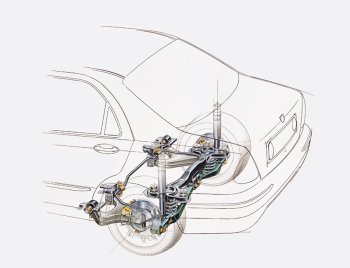
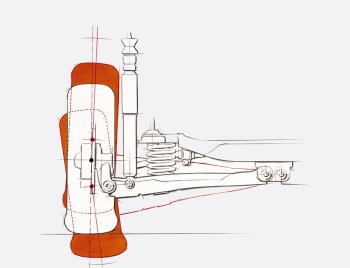 |
Continuing the
tradition of innovation, the Lybra had a brand-new
suspension design known as ‘BLG’ at the rear, which
allowed for a small amount of passive
rear-wheel steering. |
|
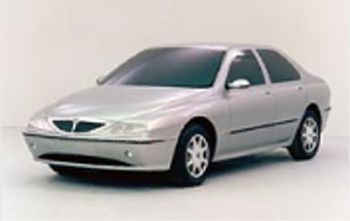
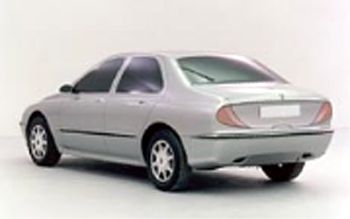
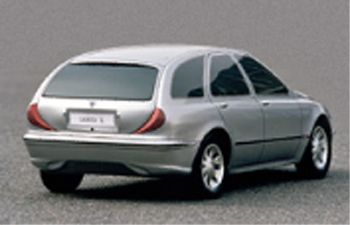 |
Fumia’s original
sketches and models for the Lancia Lybra, dating
from 1992 on, showed a clear resemblance to the 1995
Lancia Y, which was penned at around the
same time. |
|
|
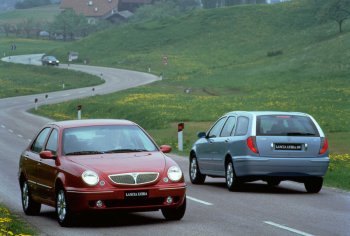 |
As the final Lancia Lybra
rolls out of the Mirafiori factory
this month after a six-year stint as Lancia’s mainstay in the very tough
compact executive segment, we pay our tribute to
this excellent, yet always underrated, wearer
of the shield. |
|
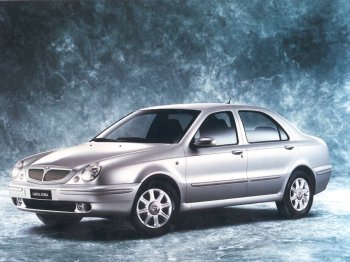
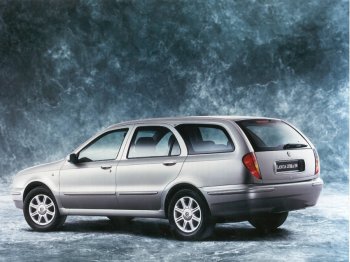 |
Impressions
released by Lancia just prior to the
new Lybra model finally made its long-awaited
and delayed public debut at the Frankfurt IAA
Motor Show in September
1999. |
|
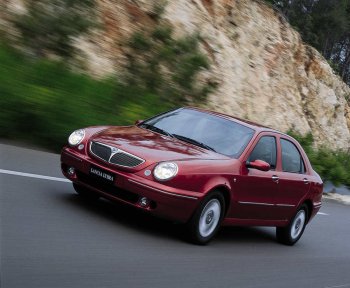 |
Although
sales figures were good for the first year of
the Lancia Lybra going on sale, they rapidly deteriorated
as the sheer weight of competition and constant updates in the compact executive
market started to weigh against the model and the lack of development attention
being paid to it. |
|
|
In-line with Fiat’s stated ambitions for Lancia at the time,
the new model was pitched towards re-establishing the marque as the luxury arm of the Fiat group, with a core
concern being passengers’ wellbeing inside the car. To this end, it included
features taken from the Lancia Dialogos concept car.
Ironically, however, it
was precisely this concept which indirectly caused the Lybra to have rather less
of an initial impact than its abilities strictly deserved. The unveiling of the Dialogos at the Turin Motor Show in April 1998 had stunned the automotive world
and established a new direction for the Lancia marque. It in turn meant,
however, that in many respects the Lybra was seen as the last of the
‘old-generation’ Lancias (or a gestation model) and little attention was paid to its part in the
much-anticipated Lancia revival, the press focusing their interest instead on
the Dialogos-influenced Kappa replacement, which would eventually emerge in 2001
as the Thesis. This was perhaps justified, as the Thesis did mark a watershed
in Lancia’s history, but it also meant that the large step forward the Lybra
represented over the Dedra was, to an extent, overlooked.
Nevertheless, for
all that, the press found plenty to like in the Lybra, even if the reviews were
not as unstinting in their praise as they had been of the Fiat group’s other
recently-launched compact executive, the Alfa Romeo 156
(launched 1997 – two years before). In
this respect, the Lybra was merely highlighting itself as a true Lancia. Much
like Saabs, Lancias are renowned for not being able to fully flourish in the
restrictive confines of a road test. Whilst their endearing nature tends to
leave a positive impression, the underlying engineering takes time to
appreciate. Indeed, this point represents a fundamental tenet of Vincenzo
Lancia’s approach to car manufacturing – his products would only demonstrate
excellence, he said, when they offered to customers much more than they expected
at first sight.
True to Vincenzo’s ideals, the Lybra demonstrated evidence of
that famed Lancia innovation, notably in its rear suspension design. The platform was
distantly related to that of the 156, with similar wheelbase and track, but
whereas the Alfa utilised a combination of double-wishbone suspension up front
and MacPherson struts at the rear located by twin transverse links, Lancia (in
the interests of prioritising ride comfort) elected to use struts at the front
and a brand-new suspension design known as ‘BLG’ at the rear, which allowed a
small amount of passive rear-wheel steering.
‘BLG’ stands for ‘Bracci Longitudinali Guidati’, or Guided Longitudinal Arm. This all-new design
essentially consisted of a transverse arm, which was jointed along the
centreline of the car, acting in concert with a conventional trailing arm. In
practice, the system operates similarly to a MacPherson strut, but the length of
the transverse arm ensures superior wheel control, as less camber changes are
induced for the same amount of suspension travel compared with a normal strut
arrangement. However, adopting
such a system was not without cost and the main drawback of BLG is the high
unsprung weight of two main locating arms, a potential problem Lancia managed to
resolve by manufacturing the arms out of aluminium.
Furthermore, the setup
offered packaging advantages, as the springs were located between the transverse
arm and the subframe, leaving the dampers occupying less space. Although a
relatively complex system, the advantages were plain to see on the road, as at
its launch the Lybra was praised for its excellent ride quality, a tribute to
the abilities of Lancia’s engineers. In its own small way, this represents
another notch on the long list of practical and resourceful Lancia innovations
over the years, a list which remains one of the marque’s hallmarks.
Continued
on Page 2 >
Page
1/2 |
|
![]()
![]()